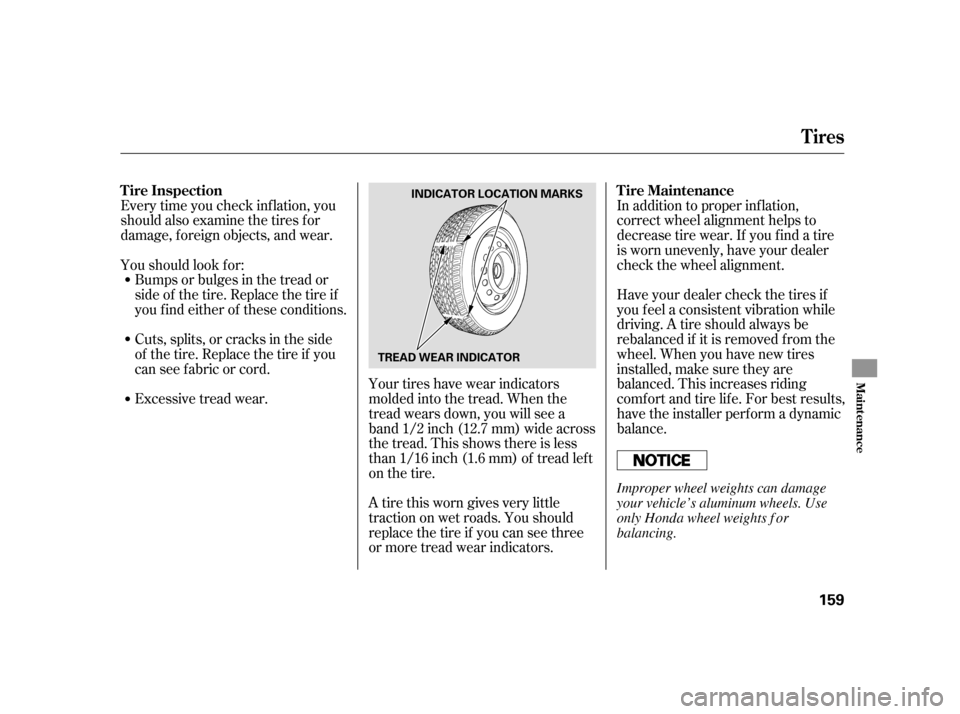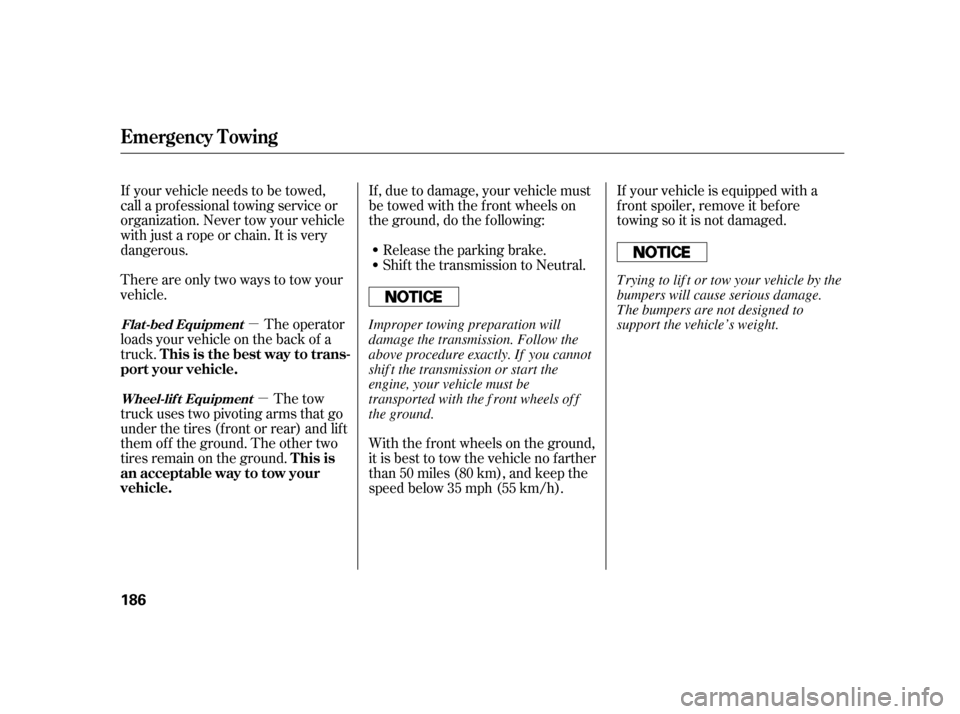Page 130 of 205

You may use a synthetic motor oil if
it meets the same requirements
given f or a conventional motor oil: it
displays the API Certif ication Seal,
and it is the proper weight. You must
f ollow the oil and f ilter change
intervals given on the maintenance
schedule.
Your vehicle does not require any oil
additives. Additives may adversely
af f ect your engine’s or transmission’s
perf ormance and durability.Always change the oil and f ilter
according to the recommendations in
the maintenance schedule. The oil
and f ilter collect contaminants that
can damage your engine if they are
not removed regularly.
Changing the oil and f ilter requires
special tools and access f rom
underneath the vehicle. The vehicle
should be raised on a service station-
type hydraulic lif t f or this service.
Unless you have the knowledge and
proper equipment, you should have
this maintenance done by a skilled
mechanic.
Run the engine until it reaches
normal operating temperature,
then shut it off.
Open the hood and remove the
engine oil f ill cap. Remove the oil
drain bolt and washer f rom the
bottom of the engine. Drain the oil
into an appropriate container.
1. 2.
CONT INUED
A dding Engine Oil, Changing the Oil and Filter
Synthetic Oil
Engine Oil A dditives Changing the Oil and Filter
Maint enance
139
OIL DRAIN BOLT WASHER
�����—�����—�
���y�
����
����
���y���
�(���)�������y���
�����y
Page 150 of 205

In addition to proper inf lation,
correct wheel alignment helps to
decrease tire wear. If you f ind a tire
is worn unevenly, have your dealer
check the wheel alignment.
Have your dealer check the tires if
you f eel a consistent vibration while
driving. A tire should always be
rebalanced if it is removed f rom the
wheel. When you have new tires
installed, make sure they are
balanced. This increases riding
comf ort and tire lif e. For best results,
have the installer perform a dynamic
balance.
Your tires have wear indicators
molded into the tread. When the
tread wears down, you will see a
band 1/2 inch (12.7 mm) wide across
the tread. This shows there is less
than 1/16 inch (1.6 mm) of tread lef t
on the tire.
Every time you check inf lation, you
should also examine the tires f or
damage, f oreign objects, and wear.
Youshouldlookfor:
Bumps or bulges in the tread or
side of the tire. Replace the tire if
youfindeitherof theseconditions.
Cuts, splits, or cracks in the side
of the tire. Replace the tire if you
can see f abric or cord.
Excessive tread wear.
A tire this worn gives very little
traction on wet roads. You should
replace the tire if you can see three
or more tread wear indicators. T ire Maintenance
Tire Inspection
Tires
Maint enance
159
INDICATOR LOCATION MARKS
TREAD WEAR INDICATOR Improper wheel weights can damage
your vehicle’s aluminum wheels. Use
only Honda wheel weights f or
balancing.
�����—�����—�
���y�
�������������y���
�(���)�������y���
�����y
Page 176 of 205

�µ�µ
If your vehicle needs to be towed,
call a prof essional towing service or
organization. Never tow your vehicle
with just a rope or chain. It is very
dangerous.
The operator
loads your vehicle on the back of a
truck.
Thereareonlytwowaystotowyour
vehicle. If , due to damage, your vehicle must
be towed with the f ront wheels on
the ground, do the f ollowing:
Release the parking brake.
Shif t the transmission to Neutral.
With the f ront wheels on the ground,
it is best to tow the vehicle no farther
than 50 miles (80 km), and keep the
speedbelow35mph(55km/h).
The tow
truck uses two pivoting arms that go
under the tires (f ront or rear) and lif t
them of f the ground. The other two
tires remain on the ground. If your vehicle is equipped with a
f ront spoiler, remove it bef ore
towing so it is not damaged.Flat -bed Equipment
Wheel-lif t Equipment
This is the best way to trans-
port your vehicle.
T his is
an acceptable way to tow your
vehicle.
Emergency T owing
186 Improper towing preparation will
damage the transmission. Follow the
above procedure exactly. If you cannot
shif t the transmission or start the
engine, your vehicle must be
transported with the f ront wheels of f
the ground.
Trying to lif t or tow your vehicle by the
bumpers will cause serious damage.
The bumpers are not designed to
support the vehicle’s weight.
�����—�����—�
���y�
�������������y���
�(���)�������y���
�����y
Page 181 of 205

�Î�Î �Î
�Î �Î �Î
Specif ications
192 Dimensions
Weights
Engine
Capacities
66.7 in (1,695 mm)
56.3 in (1,430 mm)
101.2 in (2,570 mm)
57.9 in (1,470 mm)
58.0 in (1,472 mm)
3.39 x 3.39 in (86.0 x 86.0 mm) 121.9 cu-in (1,998 cm
)
9.8 : 1 13.2 US gal (50
)
1.32 US gal (5.0
)
1.77 US gal (6.7
)
4.4 US qt (4.2
)
4.2 US qt (4.0)
5.6 US qt (5.3)
1.6 US qt (1.5)
1.8 US qt (1.7)
2.6 US qt (2.5
)
0.13 US gal (0.5
)
5.3 US qt (5.0
)
Length
Width
Height
Wheelbase
Track
Gross vehicle weight rating See the certification label attached
to the driver’s doorjamb.
Water cooled 4-stroke DOHC
i-VTEC 4-cylinder gasoline engine
Type
BorexStroke
Displacement
Compression ratio
Spark plugs
SKJ20DR-M11
IZFR6K-11 Fuel tank
Engine
coolant
Engine oil Manual
transmission
fluid
Windshield
washer reservoir
Including the coolant in the reserve tank and that remaining in the
engine.
Reserve tank capacity:
162.8 in (4,135 mm)
FrontRear Approx.
Change Manual
Total Manual
Change
Without filter
Total
ChangeTotal
NGK:
DENSO: 1: 2: 3:
U.S. models
Canadian models 1
23
Including filter
�����—�����—�
���y�
�������������y���
�(���)�������y���
�����y